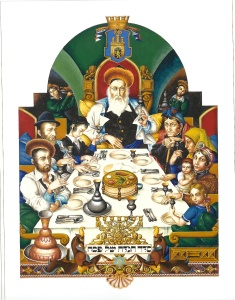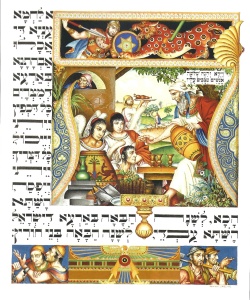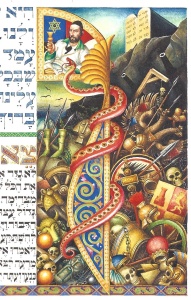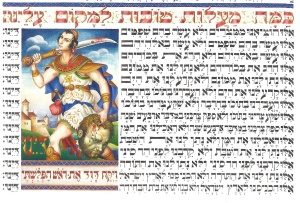To Serve My People: Part I
Arthur Szyk believed that Art can change the world and he spent his life trying desperately to prove it. In 1934 he stated “…I am resolved to serve my people with all my art, with all my heart, with all my talent, with all my knowledge.” Born in 1894 in Lodz, Poland he studied art in Paris, visited Palestine early in life, and went on to an active profession as an illustrator and political cartoonist in Lodz, Paris, London and New York. A lifelong Zionist and democrat, he fought with his artwork for the rights of Polish Jews starting in 1926 with the 45 page illumination of the Statute of Kalisz, the 13th century bill of rights of the Jews of Poland. Obviously awed by the strength of American democracy in the early 1930s he created a history of the American Revolution with 38 miniatures entitled Washington and His Times. Beginning in September 1939 he produced countless anti-fascist cartoons, satires and caricatures attacking Nazism, fascism and totalitarian ideology. Szyk was a friend of Revisionist Zionist leader Ze’ev Jabotinsky and during the war years worked as Vice Chairman of the Emergency Committee to Save the Jewish People of Europe. American journalist, novelist, playwright, screenwriter and Zionist Ben Hecht commented that Szyk was a “one-man art department for the Irgun” in the United States. His profound commitment to his ideals was forcefully expressed in almost every aspect of his artwork.
Over a thirty year career he illustrated many Jewish books including The Life of Esther, The Jew Who Laughs, The Well of Jacob, Pathways Through the Bible, The Ten Commandments, The Book of Ruth and The Book of Job. His indisputable masterpiece, The Haggadah, was created in Lodz and took two years to complete (1934-1936). Finally printed on vellum in London in 1940 the first copy was dedicated to and presented to the King of England, George VI. Through Szyk’s skill, determination and connections he managed to gain recognition of the plight of the Jewish people in many of the corridors of real political power. It is unfortunately unclear exactly what practical effect his work had on real policy and the unfolding of the murderous events in the Holocaust.
Considering Szyk’s politics the Haggadah was a natural subject. The original 1940 edition had a translation and commentary by Cecil Roth of London. The newly published 2008 version of his Haggadah provides a contemporary commentary on his images and interpretations on the basic text by Byron L. Sherwin. It states that this version “articulate[s] his vision of the world… on the brink of world war, Holocaust and catastrophe.” Szyk used his finely honed technique as an illustrator to interpret the classic text utilizing caricature, stereotype and symbolism. The images need to be “read” in an immediate and straightforward manner, yielding their meaning by examining the excruciating detail carefully. The aspect of horror vacui employed, obsessively filling almost every space with detail, is inherited from the 19th century Victorian decorative style and echoes English and Islamic medieval illuminated manuscripts as well as Egyptian hieroglyphics. It creates a feverish sensibility encouraging a kind of visual treasure hunt.
In spite of the Haggadah’s fervent call for freedom there are no overt references to Nazi oppression as the new Pharaoh. While a preparatory drawing shows Pharaoh in the guise of Hitler and close examination of some of the original artwork shows Egyptians, especially in the 1935 “We were slaves to Pharoah,” depicted with swastikas, none survived to the English 1940 publication. The Four Questions panel shows a red-backed spotted snake attacking the Israelites crossing the Red Sea. Originally the spots were swastikas but were effaced in the final version. So too in the remarkable page “In Every Generation They Stand Against Us” the same evil snake arises to attack. It would seem that overt references to Nazism were too radical while the Jewish call for freedom from bondage could still be made stridently without fear of censure.

The tone of the Szyk Haggadah is immediately established on the title page that sets the verse “If I forget thee Jerusalem…” emblazoned over the central ornamented Magen David. The very next page proclaims Szyk’s commitment to the Jewish family showing a crowded seder table presided over by a stern Eastern European patriarch. Country and Family are the foundation of this Haggadah in which every single page is elaborately illuminated.

Szyk’s work combines traditional visual motifs and wonderfully innovative interpositions of Biblical narratives to comment on the Haggadah. His use of the Torah and Midrash to comment and contextualize the traditional text forces us to re-examine both. “This is the bread of our affliction” is surprisingly illustrated with Abraham serving the three strangers, making the mitzvah of welcoming guests and feeding the poor especially relevant on this special night. Additionally we now remember the Midrash that the angels arrived on the first day of Passover. Surprisingly the figure of Ishmael bringing the roast kid shows an obedient side of his personality hitherto unknown.
Szyk follows many illuminated Haggadahs in depicting Moses being saved from the Nile by Pharaoh’s daughter. This depiction, among others of Moses, seeks to “correct” the Haggadah text that explicitly excludes Moses, the artist commenting on the heartfelt loss of our beloved leader from his narrative. Furthermore the artist asserts his personal presence in “We were slaves to Pharaoh” by depicting Jewish slaves as artists, each wearing yarmulkes, as a stone mason/sculptor and a painter making Egyptian decorations personalizing the ancient oppression of his Israelite forefathers.

The text “Blessed is He who keeps His promise to the people of Israel… but in each and every generation they arose to annihilate us” is depicted as the dust-bin of history, a vertical pile of defeated and expired civilizations that persecuted the Jews: Haman, Assyria, Rome, Spain, Czarist Russia and up to the brutality of modern warfare. All lie crushed beneath the towering Tablets of the Law. The evil serpent of Nazism coils from the depths threatening a confident Jew in the upper left who lifts a cup of wine in victory and reclines in the freedom of the night’s festival. This original and courageous image brings together a tragic history and an unwavering faith in God.

“Dayyeinu” comes to life surrounding a totally unexpected image of a confident David, bloodied sword resting on his shoulder, carrying the head of Goliath. Here Szyk visually summarizes the spirit of the song; expressing in David the grateful triumph of courage and faith over evil. He is declaring that those who defame God have no future.
In my next review we will examine more of Arthur Szyk’s unusual images in his Haggadah. His tragic death at the age of 57 cut short a courageous and principled creative career. He was and continues to be a beacon to other Jewish artists that art can function as an essential tool in the elucidation and commentary of Jewish texts and life.
Szyk Haggadah
To Serve My People: Part I
www.szyk.com